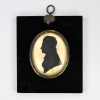Hubard, William James
Introduction:
William James Hubard was a child prodigy who began his career at the age of 13 after cutting freehand silhouettes of the congregation in his church. He was quickly taken under the wing of his business manager, a Mr. Smith, who formed ’The Hubert Gallery’ which travelled throughout the British Isles and America. He died after being blown up by a cannon ball in his own factory.
William James was the son of William and Jane Hubard, and had two brothers, Horatio and Edwin. In September 1822, while touring with Smith, he visited Ramsgate. There he was commissioned by the Duchess of Kent to cut profiles of the Duchess and various members of her large family group. A portrait of the future Queen Victoria (aged around 2 years old) was included in this group.
He left The Gallery to pursue his own career after only 15 months, though the Hubert Gallery continued to travel extensively still using his name as a draw-card. Hubard’s skill as a profilist was relatively high, though he presumably never considered it his main profession. In America he began to paint and the poet Longfellow used his pictures to illustrate his poems. He also branched into bronze casting, his first project being copies of the George Washington statue which are now scattered around the world. It was in this bronze casting factory that he met his death.
Additional research about William James Hubard:
Source: McKechnie (Author of, British Silhouette Artists and their Work 1760-1860)
Hubard, William James (McKechnie Section 1)
